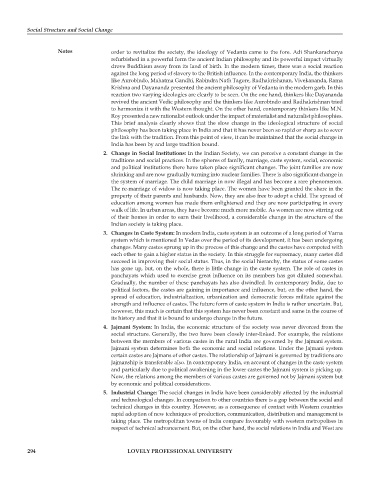Page 299 - DSOC201_SOCIAL_STRUCTURE_AND_SOCIAL_CHANGE_ENGLISH
P. 299
Social Structure and Social Change
Notes order to revitalize the society, the ideology of Vedanta came to the fore. Adi Shankaracharya
refurbished in a powerful form the ancient Indian philosophy and its powerful impact virtually
drove Buddhism away from its land of birth. In the modern times, there was a social reaction
against the long period of slavery to the British influence. In the contemporary India, the thinkers
like Aurobindo, Mahatma Gandhi, Rabindra Nath Tagore, Radhakrishanan, Vivekananda, Rama
Krishna and Dayananda presented the ancient philosophy of Vedanta in the modern garb. In this
reaction two varying ideologies are clearly to be seen. On the one hand, thinkers like Dayananda
revived the ancient Vedic philosophy and the thinkers like Aurobindo and Radhakrishnan tried
to harmonize it with the Western thought. On the other hand, contemporary thinkers like M.N.
Roy presented a new rationalist outlook under the impact of materialist and naturalist philosophies.
This brief analysis clearly shows that the slow change in the ideological structure of social
philosophy has been taking place in India and that it has never been so rapid or sharp as to sever
the link with the tradition. From this point of view, it can be maintained that the social change in
India has been by and large tradition bound.
2. Change in Social Institutions: In the Indian Society, we can perceive a constant change in the
traditions and social practices. In the spheres of family, marriage, caste system, social, economic
and political institutions there have taken place significant changes. The joint families are now
shrinking and are now gradually turning into nuclear families. There is also significant change in
the system of marriage. The child marriage in now illegal and has become a rare phenomenon.
The re-marriage of widow is now taking place. The women have been granted the share in the
property of their parents and husbands. Now, they are also free to adopt a child. The spread of
education among women has made them enlightened and they are now participating in every
walk of life. In urban areas, they have become much more mobile. As women are now stirring out
of their homes in order to earn their livelihood, a considerable change in the structure of the
Indian society is taking place.
3. Changes in Caste System: In modem India, caste system is an outcome of a long period of Varna
system which is mentioned In Vedas over the period of its development, it has been undergoing
changes. Many castes sprung up in the process of this change and the castes have competed with
each other to gain a higher status in the society. In this struggle for supremacy, many castes did
succeed in improving their social status. Thus, in the social hierarchy, the status of some castes
has gone up, but, on the whole, there is little change in the caste system. The role of castes in
panchayats which used to exercise great influence on its members has got diluted somewhat.
Gradually, the number of these panchayats has also dwindled. In contemporary India, due to
political factors, the castes are gaining in importance and influence, but, on the other hand, the
spread of education, industrialization, urbanization and democratic forces militate against the
strength and influence of castes. The future form of caste system in India is rather uncertain. But,
however, this much is certain that this system has never been constant and same in the course of
its history and that it is bound to undergo change in the future.
4. Jajmani System: In India, the economic structure of the society was never divorced from the
social structure. Generally, the two have been closely inter-linked. For example, the relations
between the members of various castes in the rural India are governed by the Jajmani system.
Jajmani system determines both the economic and social relations. Under the Jajmani system
certain castes are Jajmans of other castes. The relationship of Jajmani is governed by traditions are
Jajmanship is transferable also. In contemporary India, on account of changes in the caste system
and particularly due to political awakening in the lower castes the Jajmani system is picking up.
Now, the relations among the members of various castes are governed not by Jajmani system but
by economic and political considerations.
5. Industrial Change: The social changes in India have been considerably affected by the industrial
and technological changes. In comparison to other countries there is a gap between the social and
technical changes in this country. However, as a consequence of contact with Western countries
rapid adoption of new techniques of production, communication, distribution and management is
taking place. The metropolitan towns of India compare favourably with western metropolises in
respect of technical advancement. But, on the other hand, the social relations in India and West are
294 LOVELY PROFESSIONAL UNIVERSITY

